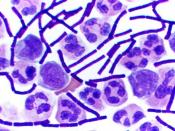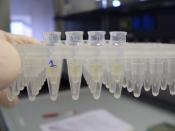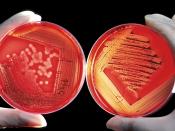According to Webster, Bacteria are defined as "microscopic, unicellular organisms" they may be small but can be found in every environment or habitat in our known world and existence. They are the means by which some life exists, some people get sick, the way certain things smell the way they do and so much more both harmful and beneficial things rely upon the presence and existents of bacterium. What we now know and classify as bacteria was first seen by Anton Leeuwenhoek in the late 1600's and later refined into definite classifications and structures in the early to mid 1800's by Ehrenberg (Wiki).
Bacteria are living things that are neither plants nor animals, but belong to a group by themselves; "they are classified as prokaryotic cells because they have no nucleus" (Text Book p64). They have one chromosome of double-stranded DNA in a ring. They reproduce primarily by binary fission: one cell will grow to approximately double its normal size ten split into two identical cells commonly called daughter cells each having the exact same genome type as the parent.
Most bacteria completely lack or have very few internal membranes, which mean that they do not have some of the organelles like mitochondria or chloroplasts. Most bacteria are benign or beneficial such as the yeast we use in raising our bread, and only a few are pathogens such as E-coli. They are very small, individually not more than a single cell, however they are normally seen as millions combined, and very few can be seen by the unassisted eye such as the common blue green "algae" found in many ponds and water bodies. The only way we are able to see those are the colonization of millions of the single celled individuals.
For bacterium to grow and develop they must...


